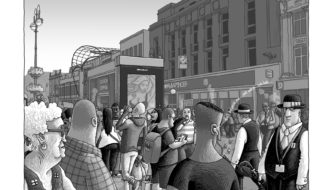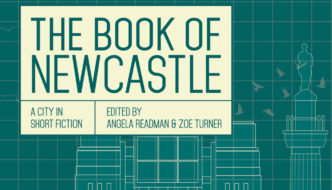
Books have the magical ability to allow us to see the world through the eyes of others. But perhaps more significantly, through relatable characters and diverse representation – stories can hold a mirror up to our own lives. They serve as a valuable reminder that we aren’t alone in this life.
Fishing for Rainbows is a wonderful story by author Oliver Sykes – inspired by Oliver’s personal experiences growing up in poverty with his father. The book follows Kezia, a 12-year-old girl being raised in a single-parent family with her brothers, following the untimely passing of their mother.
Beautifully illustrated by Georgina Reynolds and designed by Rebecca Horswill in collaboration with mentor and art director Ian Morris. Fishing for Rainbows is an inspiring and heartfelt story, sure to take you on an exciting adventure.
The collaborative project behind the visuals of the book enabled the young artists involved to gain invaluable professional experience, notoriously difficult to come by as an emerging artist in the creative industry. Combined with the mentorship they received highlights the inspirational story behind the coming together of the Fishing for Rainbows.
We are incredibly lucky to chat with this amazing creative team about the themes, artistic process, and their advice for young artists/ authors.
In your own words Oliver, can you tell us a little about the plot?
Oliver – The story is inspired by my own experience growing up without a mum, in relative poverty with my single dad.
We had to go out fishing because it was a means of getting a cheap meal. It was always me and my brothers and never my sisters. My little sister Amber always felt left out, so the book is sort of dedicated to her.
It follows a girl whose mum passed away two years ago, and she has fallen into the role of mum. Kezia cooks, cleans and maintains the house while the boys go out fishing and having adventures.
One day, she bets her dad that she can catch two fish. So, he takes her up on the bet and she goes out fishing and proves she can do just as much, if not more, than her brothers and her dad.
Most importantly she pushes them along on the journey of grief. At the end of the story this journey is a catalyst that pushes the family towards talking about their mum’s passing – which they’ve never really talked about before.
It’s really about family and coming together and not just being brave physically, but being brave mentally as well.

How did this plot inform the art style used in the design and illustrations?
Georgina – A lot of the book is set in the countryside, and I wanted to draw on those elements. Keeping a natural and homogenous colour pallet for the scenes I illustrated. Even the materials I used draw on this, such as water based and mixed media, reflect an earthy and natural element.
Rebecca – In terms of design and typography, there are a lot of page-turning moments with a lot of action, so we needed to make sure the story flowed in a way where you had to turn the page to get to the next point. Typography-wise, I used a lot of playful fonts but my most important consideration was making sure the illustrations and typography were balanced.
Ian – This balance was achieved through regular discussions where we could chat and give feedback. Both Rebecca and Georgina created a nice collaboration.
To have a designer placing the words and then having an illustrator working around them and then visa versa makes the process much easier.
Ian, you worked as a mentor on this project, can you tell us a little bit about your mentoring work?
Ian – Having worked with several art directors in my professional career, I have found that the best art directors are the ones who allowed me to use my integrity and respected that I was a professional.
Therefore, that was the way I went about working with Georgina. She’d just graduated but she’d still studied for years and developed her voice. I was mainly there to facilitate and oversee. I’m a big believer that we create our best work in our most relaxed state, given the space to create a connection with the work.
Georgina – Ian was a great mentor, when you come out of university you have this idea of who you want to be as a creative. You know how you want things to appear.
Ian was a helping hand in pointing out the little things that I could tweak, we had a lot of discussions about the work which I benefited from. Illustrating can be a lonely experience; you’re often working by yourself, and Ian brought a more direct collaboration to the project.

The book was born of a collaborative process, how did that inform the work?
Rebecca – Collaboration has been such a big part of my creative process throughout my education. So, to get the opportunity to do it professionally has been so insightful. Not having come from a design background, being in this environment with people who have a depth of experience has benefited me. The collaboration was a very smooth process.
Georgina – It was nice to have critical and technical feedback from Ian, but it was also nice to get encouragement. Like if I did something I thought was a bit rubbish, Oliver would say it was great and that gave me confidence. That was one of the take home things from this project. That we were all able to boost and support each other.
What is your favourite line in the book? / Which was your favourite visual aspect of the book?
Oliver – The last line of the story is “Wherever you are mum, thank you” spoken by Kezia. The mum has been a presence throughout the book, she’s not a physical character but illustrated in a memory. That would probably be my favourite line because it brings everything together.
People leave us but they never truly leave, and we carry them with us. In terms of a visual, the bubble illustration of Kezia and her mum washing up, mainly because I didn’t imagine that part illustrated. It was lovely to see Kezia’s memory of her with her mum.
Rebecca – My favourite visual is where Kezia is under the water, when I look at it it’s almost silent… but then on the next page it says SPLOSH. It’s the contrast between the two.
Georgia– One of my favourite visuals is where Kezia and her family are sitting on their bookshelf, it’s a bit more conceptual. That was one of my favourite visuals to create as well because the bookcase appears earlier in the background on a different page and if you look closely, you can see the exact section of the bookshelf which is then blown up within that scene. I love the little details like that.

What advice would you give to your younger self?
Georgina – Keep drawing. I learned so much over the process by constantly creating and observing. Just keep at your practice and your craft. Stand by what you want and how you want your work to look. It’s easy to get swayed by trends in the visual arts but stick to your guns and do what makes you happy.
Ian –Mentality is so important. Being positive and surrounding yourself with people who want to do great things. I’m from a very working-class area and not many go on to do anything creative, when you’re from areas and backgrounds you don’t always get these opportunities so when you do it feels like a golden ticket. So, if it doesn’t work out it can feel like it’s never going to happen again but if you keep that positivity and believe that there is something else around the corner and not get disheartened.
Rebecca – Always be kind to the people you interact with and build those connections. A big part of being a creative person is being open and welcoming to everyone you meet because if you’re closed off or have a harsh attitude towards receiving feedback you’ll struggle to get to the next steps. Don’t give up and have an open mind to everything that comes towards you.
Oliver – Study storytelling. Work out the craft. Learn what makes a good story and then write based on what you’ve learned. So many ideas fizzle out when you don’t know how it’s done. Learning how stories are structured and creating a plan for the story I wanted to tell was how I was able to finish writing stories.
It was such a pleasure to talk to Oliver, Georgina, Rebecca and Ian and learn more about their work, creative process and inspirations. Seeing a project that not only shines a light on under represented issues but also offers an inspiring opportunity for young artists and designers to gain professional experience.
Fishing for Rainbows is available now and can be purchased on Author Oliver Sykes website here.
Follow Amanda on Instagram.

“>




Comments